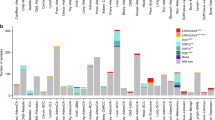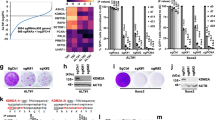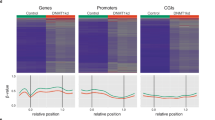Abstract
Hypomethylation of repeated elements in the genome is a common feature of human cancer, however, the direct consequences of this epigenetic defect for cancer biology are still largely unknown. Telomeres are specialized chromatin structures at the ends of eukaryotic chromosomes formed by tandem repeats of G-rich sequences and associated proteins, which have an essential role in chromosome end protection and genomic stability. Telomeric DNA repeats cannot be methylated, however, the adjacent subtelomeric DNA is heavily methylated in humans. Here, we show that the methylation status of subtelomeric DNA repeats negatively correlates with telomere length and telomere recombination in a large panel of human cancer cell lines. These findings suggest that tumor telomere length and integrity can be influenced by epigenetic factors. Finally, we show that treatment of human cancer cell lines with demethylating drugs results in hypomethylation of subtelomeric repeats and increased telomere recombination, which in turn may facilitate telomere elongation. All together, these findings suggest that tumor telomere length and integrity can be influenced by the epigenetic status of cancer cells.
This is a preview of subscription content, access via your institution
Access options
Subscribe to this journal
Receive 50 print issues and online access
$259.00 per year
only $5.18 per issue
Buy this article
- Purchase on Springer Link
- Instant access to full article PDF
Prices may be subject to local taxes which are calculated during checkout














Similar content being viewed by others
References
Bailey SM, Cornforth MN, Kurimasa A, Chen DJ, Goodwin EH . (2001). Strand-specific postreplicative processing of mammalian telomeres. Science 293: 2462–2465.
Bailey SM, Brenneman MA, Goodwin EH . (2004). Frequent recombination in telomeric DNA may extend the proliferative life of telomerase-negative cells. Nucleic Acids Res 32: 3743–3751.
Bechter OE, Zou Y, Walker W, Wright WE, Shay JW . (2004). Telomeric recombination in mismatch repair deficient human colon cancer cells and telomerase inhibition. Cancer Res 64: 3444–3451.
Benetti R, Gonzalo S, Jaco I, Schotta G, Klatt P, Jenuwein T et al. (2007a). Suv4-20h deficiency results in telomere elongation and derepression of telomere recombination. J Cell Biol 178: 925–936.
Benetti R, García-Cao M, Blasco MA . (2007b). Telomere length regulates the epigenetic status of mammalian telomeres and subtelomeres. Nat Genet 39: 243–350.
Blackburn EH . (2001). Switching and signaling at the telomere. Cell 106: 661–673.
Blasco MA . (2004). Carcinogenesis Young Investigator Award. Telomere epigenetics: a higher-order control of telomere length in mammalian cells. Carcinogenesis 25: 1083–1087.
Blasco MA . (2005). Telomeres and human disease: cancer, ageing and beyond. Nat Rev Genet 6: 611–622.
Blasco MA . (2007). The epigenetic regulation of mammalian telomeres. Nat Rev Genet 8: 299–309.
Canela A, Vera E, Klatt P, Blasco MA . (2007). High-throughput telomere length quantification by FISH and its application to human population studies. Proc Natl Acad Sci USA 104: 5300–5305.
Collins K, Mitchell JR . (2002). Telomerase in the human organism. Oncogene 21: 564–579.
De Lange T . (2005). Shelterin: the protein complex that shapes and safeguards human telomeres. Genes Dev 19: 2100–2110.
Dunham MA, Neumann AA, Fasching CL, Reddel RR . (2000). Telomere maintenance by recombination in human cells. Nat Genet 26: 447–450.
Flores I, Benetti R, Blasco MA . (2006). Telomerase regulation and stem cell behaviour. Curr Opin Cell Biol 18: 254–260.
Fraga MF, Uriol E, Borja Diego L, Berdasco M, Esteller M, Canal MJ et al. (2002). High-performance capillary electrophoretic method for the quantification of 5-methyl 2′-deoxycytidine in genomic DNA: application to plant, animal and human cancer tissues. Electrophoresis 23: 1677–1681.
Fraga MF, Ballestar E, Villar-Garea A, Boix-Chornet M, Espada J, Schotta G et al. (2005). Loss of acetylation at Lys16 and trimethylation at Lys20 of histone H4 is a common hallmark of human cancer. Nat Genet 37: 391–400.
Garcia-Aranda C, de Juan C, Diaz-Lopez A, Sanchez-Pernaute A, Torres AJ, Diaz-Rubio E et al. (2006). Correlations of telomere length, telomerase activity, and telomeric-repeat binding factor 1 expression in colorectal carcinoma. Cancer 106: 541–551.
García-Cao M, Gonzalo S, Dean D, Blasco MA . (2002). Role of the Rb family members in controlling telomere length. Nat Genet 32: 415–419.
García-Cao M, O’Sullivan R, Peters AH, Jenuwein T, Blasco MA . (2004). Epigenetic regulation of telomere length in mammalian cells by the Suv39h1 and Suv39h2 histone methyltransferases. Nat Genet 36: 94–99.
Gonzalo S, Blasco MA . (2005). Role of Rb family in the epigenetic definition of chromatin. Cell Cycle 4: 752–755.
Gonzalo S, García-Cao M, Fraga MF, Schotta G, Peters AHFM, Cotter SE et al. (2005). Role of the RB1 family in stabilizing histone methylation at constitutive heterochromatin. Nat Cell Biol 7: 420–428.
Gonzalo S, Jaco I, Fraga MF, Chen T, Li E, Esteller M et al. (2006). DNA methyltransferases control telomere length and telomere recombination in mammalian cells. Nat Cell Biol 8: 416–424.
Guilleret I, Benhattar J . (2003). Demethylation of the human telomerase catalytic subunit (hTERT) gene promoter reduced hTERT expression and telomerase activity and shortened telomeres. Exp Cell Res 289: 326–346.
Harley CB, Futcher AB, Greider CW . (1990). Telomeres shorten during ageing of human fibroblasts. Nature 345: 458–460.
Herman JG, Graff JR, Myohanen S, Nelkin BD, Baylin SB . (1996). Methylation-specific PCR: a novel PCR assay for methylation status of CpG islands. Proc Natl Acad Sci USA 93: 9821–9826.
Kitagawa Y, Kyo S, Takakura M, Kanaya T, Koshida K, Namiki M et al. (2000). Demethylating reagent 5-azacytidine inhibits telomerase activity in human prostate cancer cells through transcriptional repression of hTERT. Clin Cancer Res 6: 2868–2875.
Kondo T, Bobek MP, Kuick R, Lamb B, Zhu X, Narayan A et al. (2000). Whole-genome methylation scan in ICF syndrome: hypomethylation of non-satellite DNA repeats D4Z4 and NBL2. Hum Mol Genet 9: 597–604.
Muntoni A, Reddel RR . (2005). The first molecular details of ALT in human tumor cells. Hum Mol Genet 14: 191–196.
Samper E, Goytisolo FA, Slijepcevic P, van Buul PP, Blasco MA . (2000). Mammalian Ku86 protein prevents telomeric fusions independently of the length of TTAGGG repeats and the G-strand overhang. EMBO Rep 1: 244–252.
Shay JW, Wright WE . (2006). Telomerase therapeutics for cancer: challenges and new directions. Nat Rev Drug Discov 5: 577–584.
Steinert S, Shay JW, Wright WE . (2004). Modification of subtelomeric DNA. Mol Cell Biol 24: 4571–4580.
Acknowledgements
EV is a predoctoral fellow of the Spanish Ministry of Education and Science (MEC). MA Blasco's Laboratory is funded by the MEC (SAF2005-00277, GEN2001-4856-C13-08), by the Regional Government of Madrid (GR/SAL/0597/2004), European Union (TELOSENS FIGH-CT-2002-00217, INTACT LSHC-CT-2003-506803, ZINCAGE FOOD-CT-2003-506850, RISC-RAD FI6R-CT-2003-508842, MOL CANCER MED LSHC-CT-2004-502943) and the Josef Steiner Cancer Research Award 2003.
Author information
Authors and Affiliations
Corresponding author
Additional information
Supplementary Information accompanies the paper on the Oncogene website (http://www.nature.com/onc)
Supplementary information
Rights and permissions
About this article
Cite this article
Vera, E., Canela, A., Fraga, M. et al. Epigenetic regulation of telomeres in human cancer. Oncogene 27, 6817–6833 (2008). https://doi.org/10.1038/onc.2008.289
Received:
Revised:
Accepted:
Published:
Issue Date:
DOI: https://doi.org/10.1038/onc.2008.289
Keywords
This article is cited by
-
Telomere-based treatment strategy of cardiovascular diseases: imagination comes to reality
Genome Instability & Disease (2024)
-
TGS1 mediates 2,2,7-trimethyl guanosine capping of the human telomerase RNA to direct telomerase dependent telomere maintenance
Nature Communications (2022)
-
Ageing affects subtelomeric DNA methylation in blood cells from a large European population enrolled in the MARK-AGE study
GeroScience (2021)
-
Impact of DAXX and ATRX expression on telomere length and prognosis of breast cancer patients
Journal of the Egyptian National Cancer Institute (2020)
-
SFPQ and NONO suppress RNA:DNA-hybrid-related telomere instability
Nature Communications (2019)



